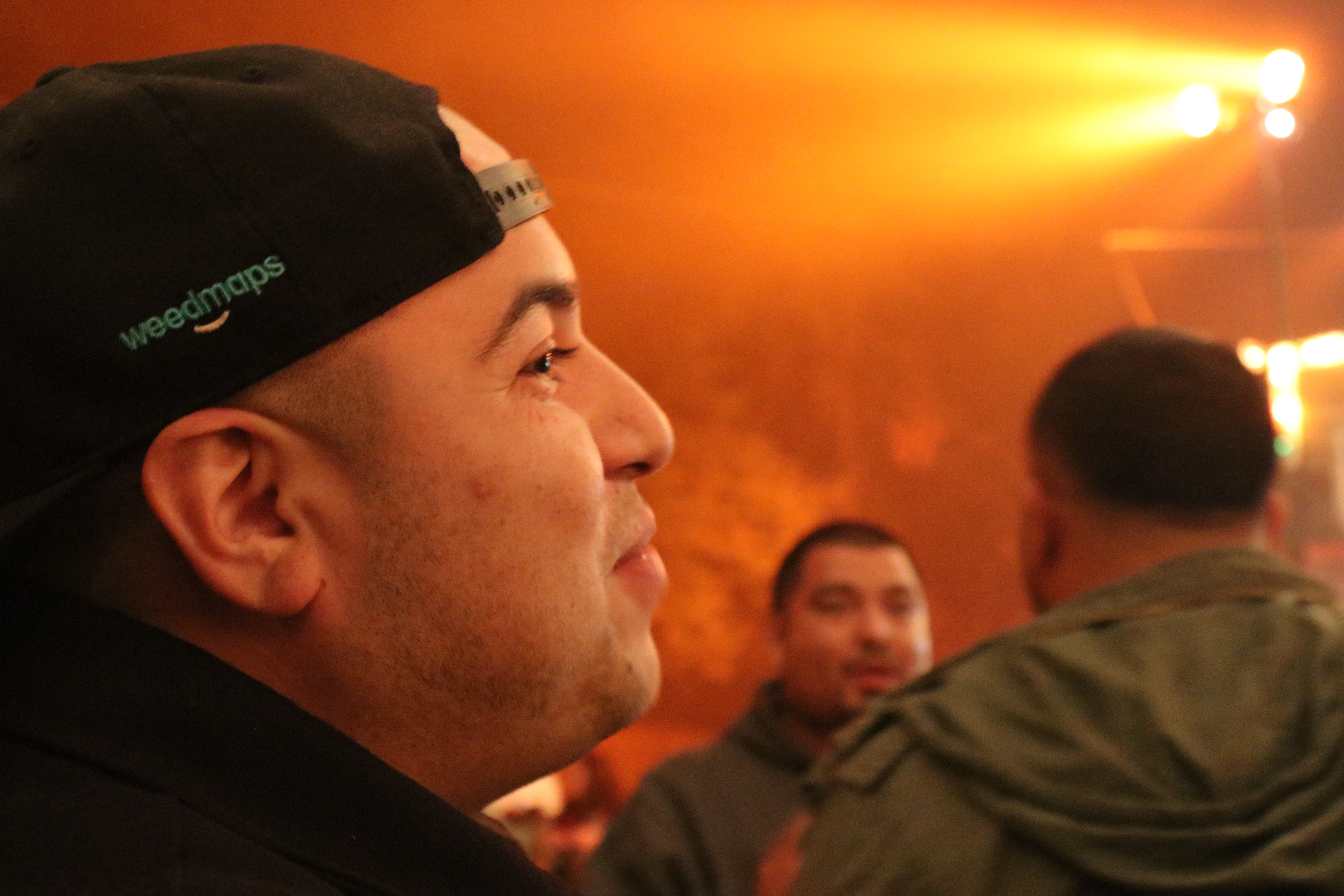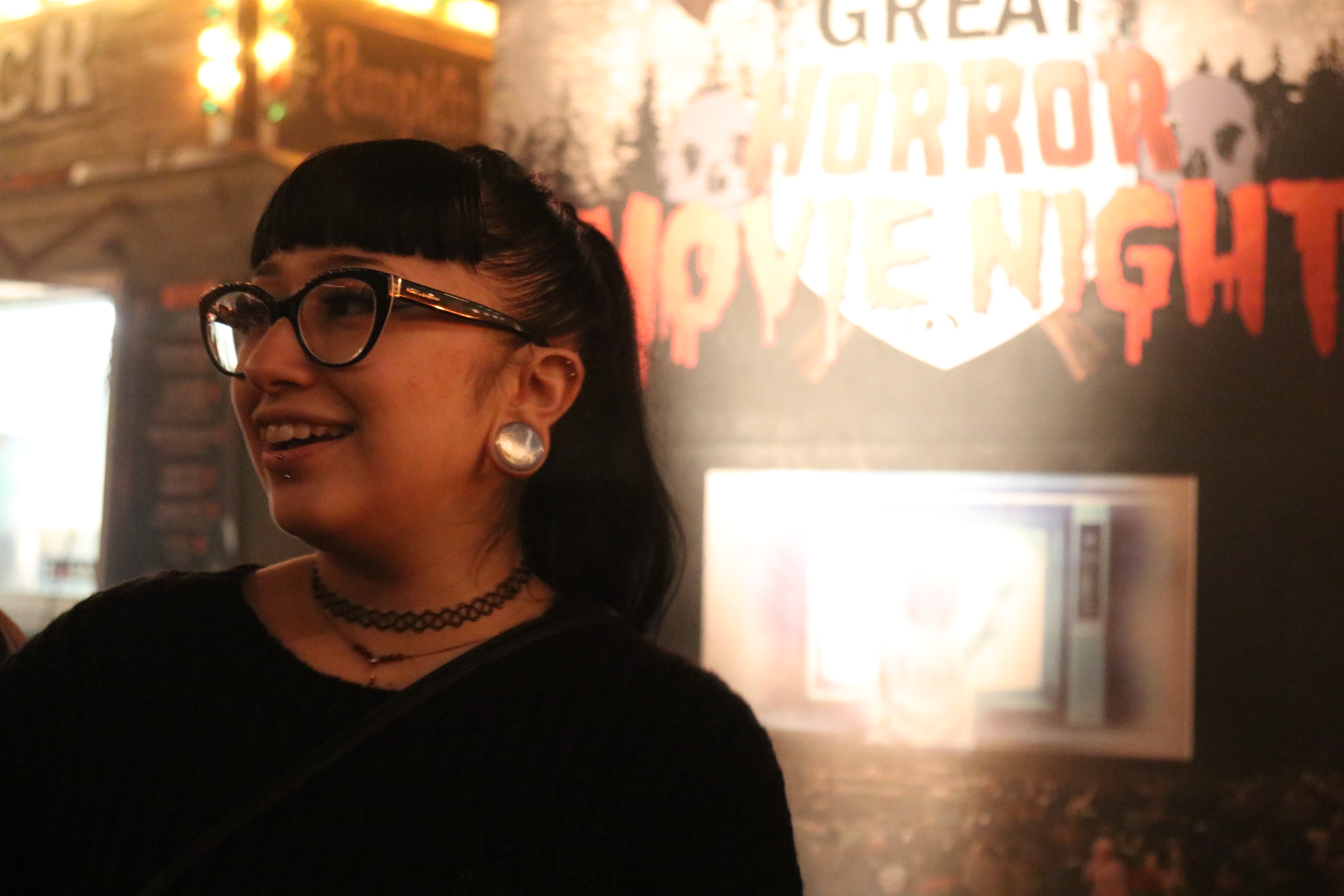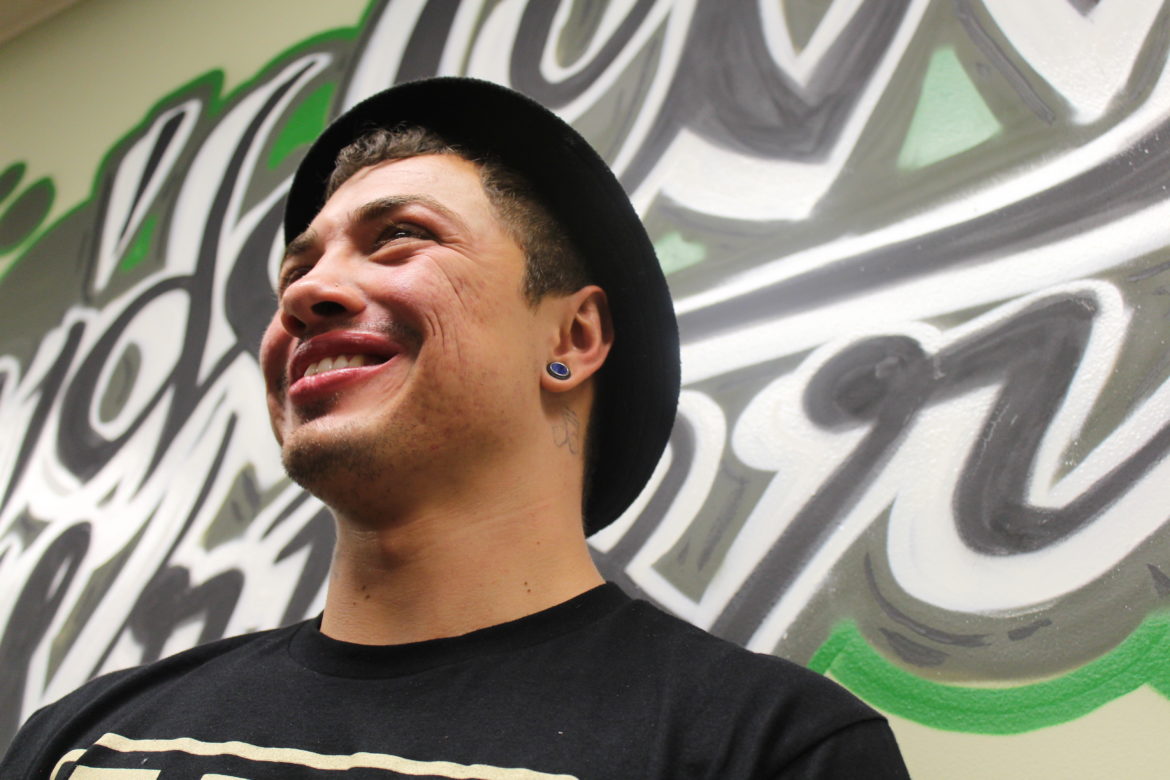
Photos by Marisa Zocco
The entrance to the Los Angeles Haunted Hayride
LOS ANGELES — Near a wooden “Death Row” signpost towering in an orange-lit fog, 25 young people huddled together, smiling and laughing.
Few would guess the crowd waiting to enter the Los Angeles Haunted Hayride and Corn Maze was almost entirely made up of formerly incarcerated youth whose daily lives are in some ways more surreal than a scary event.
 Used to a totally regulated life on the inside, they are uncertain how to navigate life on the outside again.
Used to a totally regulated life on the inside, they are uncertain how to navigate life on the outside again.
“You’re literally emerging from a time capsule,” said Jimmy Wu, who was incarcerated as a teen in the early ’90s. “Even the pace of life — why didn’t you tell us we were going to be leaving a world that moves in slow motion for a world out here in fast forward?”
Wu and the group of young adults he accompanied are members, or alumni, of InsideOUT Writers (IOW), a nonprofit organization that provides programming and resources to youth affected by the juvenile justice system. On the inside, while incarcerated, youth in the program benefit from creative writing classes, introspective journal entries and taking part in writing retreats. On the outside, after release, students are provided with mentorship, resources, writing circles and fun programming to help deal with their struggles with handling masked emotional demons, and navigating their way through the maze of reentry horrors.
“A lot of our alum ... thought the end of the world was at the end of their block,” said Wu, IOW’s alumni advocacy director. “Once in awhile we give them the opportunity to just get out there, have fun and be the young people they are.”

IOW member Jesse Molina smiles as he watches other members have fun.
Daniel Bisuano, 21, has been in and out of the system since committing his first offense when he was just 12. Soft-spoken, he said he had to adhere to a persona on the inside to adjust to the juvenile justice system’s predator or prey lifestyle.
“In jaiI, I chose to play the role of gangbanger, but when I am in interviews or whatever, people are like ‘Whoa, you sound so smart,’ and I’m like, ‘That’s because I am,’” Bisuano said. “It’s a mask. In there you’re either a wolf or bunny. I had to defend myself a lot, and that mask helped me defend myself.”
But, after being worn for years, the mask became difficult to shed. According to Bisuano, that’s where a small program like the hayride, or a larger one like a previous tour of colleges in Northern California, can make a big difference in sticking to a new lifestyle on the outside.
“A lot of experiences I’ve had here, I’ve never had before,” he said. “Seeing colleges and being able to think that I even have a chance of going there opened my eyes. I felt like I belonged. These events bring me a sense of joy and of myself. I’ve hidden me for so long that I didn’t know who I was.”
IOW’s writing program, Bisuano said, has helped him be introspective enough to realize that.

IOW member Jessica Martinez takes a break.
On the inside, according to Sarah Bryer, executive director of the National Juvenile Justice Network, the rigid structure and exaggerated power dynamics often create an environment that shuts down communication and expression.
“These kids are told all the time that they are not worth anything, that they belong in these facilities,” Bryer said.
Options to remedy situations when youth feel they’ve been mistreated, she said, are very narrow, and the youth sometimes risk personal harm raising those concerns.
“Having adults come in from the outside, have that relationship, and give the implicit and explicit statements to these young people that they are valued and can accomplish great things in this world is tremendously important,” Bryer said.
Youth facilities have a constitutional obligation to provide adequate and supportive services for all committed youths under joint guidelines from the U.S. departments of Education and Justice that came out in December 2014. Research cited in the guidelines has proven that humane treatment provided with care and concern is more effective in rehabilitating youth. Unfortunately, according to Bryer, many facilities fall short of that.
“It’s great to have outside groups come in but that should be on top of the quality education that they receive on the inside,” Bryer said. “Facilities need help, and some have a more open door. The more we can get community volunteers in those facilities to get them to work with people, the more normalized, the more connected, and the better the outcome in the long run. Not all facilities are as eager but they should be.”
Whether on the East or West Coast, resources like those of IOW and similar Washington, District of Columbia organization Free Minds Book Club offer, provide a sense of community not found in most juvenile detention centers. That sense of community, says 18-year-old IOW alum, Rose Morita, has been instrumental.
[Related: Imprisoned as Teens, Speaking Out as Free Men for Change in Juvenile System]
Morita, who has spent the past 17 years in 37 different homes, placed there by child protective services, said IOW’s biggest strength has been helping her to communicate instead of avoiding connection with others.

Daniel Bisuano laughs at having his portrait taken.
“The only reason I got into it is because the staff on the inside wanted me out of my room,” Morita said of getting involved with the program. “I never came out, and would skip meals half the time. They kind of forced me into it but I ended up liking it.”
Since the first time she made her group members cry with her writing, the program’s pace and its writing circles, she says, has become her “safe haven.” Its entertaining outings serve as a break from what could easily become roadblocks to reentry.
“It gives you time to escape placement or the current situations you’re in. It can get your mind off of all of your problems,” Morita said.
The night of the hayride, there were three fights and two arrests in her current placement home in Hollywood. A staff member was hospitalized due to one of the fights, she said. Had she been there when the fighting broke out, Morita, who takes medication for impulsivity, speculated she might have been pulled in.
With a job interview lined up, her own apartment on the horizon, law classes at community college set to begin in January, and finally being put back in touch with family, the fear of failing to keep it together just a little while longer is a reality far more frightening than a haunted hayride.
The same goes for Bisuano, a recovering addict. When he was younger, his fears about transitioning from the inside to the outside centered around drugs and creating a social life — when he could get his next fix, what school was going to be like and if he was going to be popular.
Those concerns changed after he was charged with a felony, and a subsequent DUI car crash put him in a three-day coma. Now enrolled in a 12-step recovery program, and four months clean and sober, Bisuano said rehabilitation, writing skills he learned with IOW and the family connections he has been able to create with other alum help him cope with his fears. The biggest: failure to make it on the outside.
“I say to myself: When I get to a place where I can take care of myself … that’s when I get there, but for now I’m focused on surviving. I don’t want to survive anymore, I want to thrive. But right now I have to survive.”
With a lack of funding leading to shrinking staff, Bisuano said it’s hard to get connected with vital resources like he used to. He often eats one meal a day of a sandwich and vegetables, but says he’s used to it. He estimates he’s lost 20 pounds since his last release in August. When the cousin he’s been living with moves in with her father later this month, Bisuano will have no place to stay except a shelter. His full-time job is looking for work.
“I’ve been on the verge of life and death,” he said. “Death was easy. Seeing people dressed up in [Halloween] masks is easy. But life — just getting integrated back into society is scary. You know, the lifestyle I knew was jail. Everything was easy in there. I’m afraid of not being able to do [life on the outside].”
He recognizes the importance of surrounding himself with a strong community, one he says inspires him to aspire to be better, get an education and continue advocating.
Morita agrees that that describes the IOW space.
“I live by this quote,” Morita said. "It says, ‘Even the darkest skies can create the brightest stars.’ Bad situations are the leading cause to better events. You can still come out and see clearer and better than you did before. IOW can really help with that.”
Youth Today has partnered with IOW’s alumni program in our Youth Voices column since 2015.